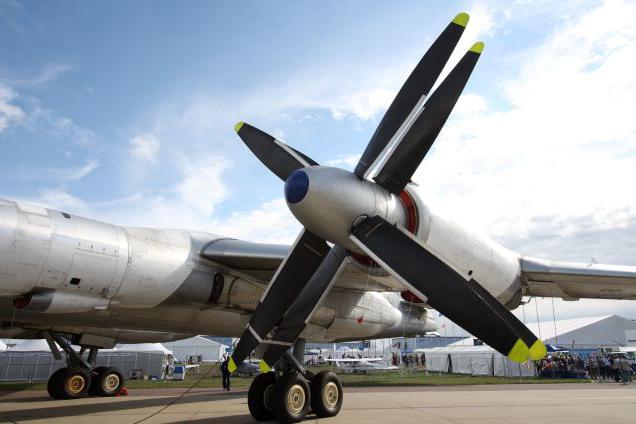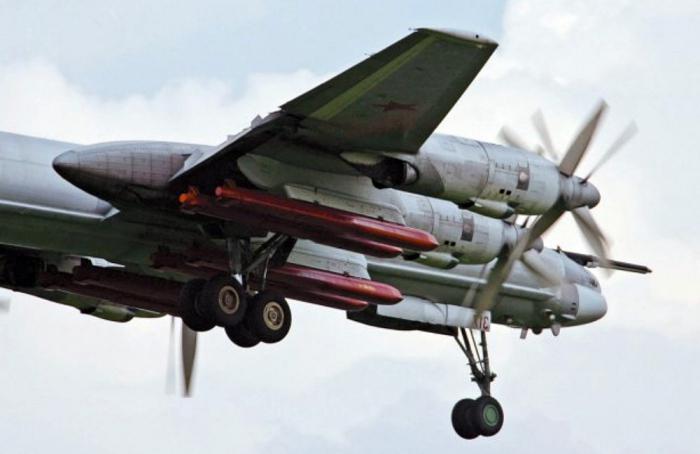After the Russian Federation resumed flights of strategic aviation carriers on alert, reports began to appear in the press that Tu-95MS aircraft were seen near the air borders of Great Britain, the island of Guam, Japan and other places where such activity had not previously been observed. Our Air Force does not violate air lines, but they come close to them, which is perceived as unfriendly behavior. Sometimes interceptors of NATO countries fly out to intercept (conditional) , and the incident is considered exhausted. The only Tu-type helical strategic bomber in the world, some military observers call the "relict" one. Despite such an offensive nickname, its appearance near the training areas of the armies and fleets of the countries of probable opponents is disturbing. Why?
Beginning of the E-Bom era
Tu-95MS "Bear" is a direct descendant of the "aircraft-95-1", which first took off in the fall of 1952. Operation in flight units began in 1956, approximately at the same time when the famous B-52 appeared in America, serving today. These events were preceded by a certain background.
In August 1945, US aviation carried out two atomic bombings of Japanese cities. Political scientists are still arguing about the military expediency of this action, but the psychological effect, of course, has taken place. The era of atomic psychosis began. It was clear to the Stalinist leadership that without its own nuclear forces the USSR would lose its geopolitical independence. At the same time, the bomb itself (it has already been developed) is not enough; we need means of delivery. The first and fully justified measure taken in this direction was the copying of the Boeing B-29 Stratofortress, which we called the Tu-4. In 1950, the war began in Korea, in which American troops, according to the already traditional and tried and tested strategy, relied on carpet bombings carried out by large air connections flying in tight formation. The system, however, failed.
How the Bear was created
After the MiG-15 fighter jets appeared in the Korean sky, the vulnerability of the B-29 became apparent. The paradox of the situation was that, with their own hands, Soviet aircraft designers proved the untenability of the concept of an atomic bomber with a piston engine (that is, Tu-4), and the USSR had no others at that time. As a matter of urgency, work on the promising Tu-85 model was curtailed due to its obsolescence already at the design stage. KB A.N. Tupolev was instructed to create a new carrier aircraft of free-falling large-capacity bombs, which could fly much higher, faster and have a larger combat radius. Such a project could only be realized using turbine engines. In mid-1951, work began. By 1952, they were successful, the result was a plane with a modest index of "95", transported to the Zhukovsky airfield and mounted there. Outwardly, it almost did not differ from the Tu-95MS, flying to this day.
General scheme
By today's standards, the layout of the Bear (as it was called in NATO) is not amazing. The scheme is classical, the fuselage is round (the usual solution for Tupolevites), the wing is swept, mid-located. The surprise of specialists in the early fifties would have been caused by very long engine nacelles, due to the high engine power, and an unusual propulsion scheme. The Tu-95MS aircraft is equipped not with four (like B-17 or B-29) propellers, but eight. Two propellers rotate on the axis of each motor (thanks to a very interesting gearbox), the inclination of the blades of which also has an opposite direction. Thus, they direct air in a coordinated manner, thereby achieving a very high efficiency (up to 82%). This decision immediately brought the parameters of the Tu-95MS power plant to a qualitative level close to the turbojet characteristics.

In addition to these unusual moments, the geometric dimensions of the airframe also impress. Its length and wingspan are approximately 50 meters. Take-off weight - more than 180 tons.
As for the mass of the combat load, at the time it was put into service, it was 12 tons, but in the process of finalizing and improving the design it was possible to bring it to 20 tons (the Bear-Tu-95MS carries so much).
"From the corner"
The growing capabilities of air defense systems both in the USSR and in the countries militarily opposing it, gradually nullified the idea of using free-falling bombs, especially those equipped with special charges. The United States and the Soviet Union at the time of recognition of this fact had hundreds of solid and durable machines with a number of unique flight characteristics (range, speed, carrying capacity). Large amounts of money were spent on their development and construction. It was required to find them a new application. It is unknown who came up with the idea of using a bomber aircraft as a flying launcher for cruise missiles, but it turned out to be saving for a whole class of aircraft. The modified Tu-95MS bomber has become such an “air battery”, designed to launch the KR from neutral zones, without entering the enemy’s airspace and firing unexpectedly, as from around the corner.
Civil version
Since the fifties (and in some cases from earlier times), bombers have become a kind of "donor" of the passenger air fleet. This phenomenon is most characteristic of the work of KB A.N. Tupolev, just remember the famous Tu-104, which is a conversion of the combat Tu-16. For a long time, the state considered it unnecessary to design exclusively civilian vehicles, preferring to use ready-made structures and their adaptation. The Tu-95MS aircraft has been operating much longer than the other version of the “95th”, the passenger Tu-114, which has already served in Aeroflot and even managed to deliver General Secretary Khrushchev to the United States.
Self defense
In the 50s and 60s, even An-12 transport aircraft were equipped with fodder firing points. Today, these weapons seem outdated, and the very idea of using aircraft guns to defend against fighters is naive. Nevertheless, the Tu-95MS missile carrier has retained the artillery installations, their caliber is 23 mm. In the earlier versions there were more of them (up to six trunks, 3 paired systems). They are unlikely to help against an air-to-air missile, but give a certain chance to repel an attack of a fighter from the rear hemisphere. By their design, installations with GSh-23 guns are approximately identical to those used for the Tu-4; artillery equipment is generally conservative.
Main weapon
X-55 cruise missiles are the main armament of the Tu-95MS bomber. Their characteristics deserve a separate article, but the method of their integration into the aircraft structure is original and elegant in its own way. Inside the fuselage are six shells with folded wings, similar to how cartridges are located in the drum of a revolver. After launching one rocket, the entire internal system rotates 60 degrees, and the next X-55 is ready for separation through a spacious bomb gate.
Underwing pylons (there are four of them) are designed for the suspension of another ten cruise missiles, the aircraft's carrying capacity allows it to carry such weight, although flight characteristics are reduced, aerodynamic drag and, as a result, fuel consumption are increased, and flight range is reduced.
Crew working conditions
Tu-95MS is not the most comfortable car. The pilot's cabin is rather crowded, although many unpleasant factors characteristic of earlier versions are now eliminated. The crew of the front pressurized cabin takes places, climbing the high ladder through the hatch in the lower bow, next to the front landing gear, through which he leaves the plane in case of emergency. To speed up the process, a kind of conveyor is provided, but a parachute jump down is always more dangerous, since most flight accidents occur at low altitudes (during takeoff and landing). The catapult as such is absent.
The rear pressurized cabin is equipped with its own sunroof. To save during an accident over the sea, inflatable rafts are provided.
Pilots complain of a high noise level (the engines are very powerful, 15 thousand liters each, and there are eight huge screws). The toilet is also inconvenient. However, it should be borne in mind that work on the design of the 95th began back in the Stalin era, when little attention was paid to convenience issues.
Prospects
After the collapse of the Union, the Engels long-range airfield “Engels” in the Saratov Region became the main base for 32 units out of 90 manufactured aircraft of this modification. In 1992, the release of the Bears Tu-95MS was completed. The characteristics of the missile carrier allow the leadership of the Ministry of Defense to count on the possibility of their operation for at least another ten years.

A flight range of 6 to 10 thousand km provides combat capabilities inherent in aircraft of subsequent generations. A speed of up to 900 km / h corresponds to the parameters of the aforementioned B-52 bomber, performing similar functions. The ability to install electronic warfare equipment eliminates the high visibility of the Bear for hostile radars. Timely prevention contributes to the extension of motor resources. Nevertheless, the Tu-95 are doomed to decommission after the last of them has exhausted the margin of safety. In their place in the system will stand modern strategic missile carriers.